Malta’s delightful capital Valletta was laid out by the Knights of Malta in the 16th century and is a UNESCO World Heritage Site, packed with stunning architecture. Valletta makes an ideal city break destination where you can find world class restaurants, peek inside a stunning Palazzo or dip into Malta’s WW2 history. We cover the top things to do in Valletta, whether you are visiting for the day, or have a little longer to linger.

This article may contain affiliate links that provide commission on purchases you make at no extra cost to you. As an Amazon Associate I earn from qualifying purchases.
Valletta and the Knights of Malta
To understand Valletta you need to know something about the Knights of Malta. The religious Order of Saint John was founded to help pilgrims going to the Holy Land. Following their expulsion from Rhodes, they were given sovereign powers over Malta by Charles V, where they made their base from 1530.
With the Mediterranean dominated by the Ottomans, the Knights took on the role of defending Christianity from the advance of the Ottoman empire, which they did fiercely during the siege of Malta in 1565. After the siege the new and well fortified city of Valletta was laid out by the Knight’s leader, Grand Master Jean Parisot de la Valette.

Malta’s strategic position in the Mediterranean
The deep water harbours on either side of Valletta made Malta a coveted military and trading centre in the Mediterranean, which the British used as their naval base until 1979. Due to its strategic position, Valletta and Malta suffered terrible bombardments during World War 2 and the whole nation was awarded the George Cross for their courage and endurance.
Now most of the city has been rebuilt, but there’s still work to do and you will see dusty, abandoned buildings next to those that have been beautifully restored. Valletta is also a great place to base yourself if you want to see other parts of Malta. Many of Malta’s highlights can be easily visited on a day trip from Valletta and there’s a good network of public buses that can take you to all parts of the island.
Read about the Three Cities of Malta – what to know before you visit

Top 6 Things to do in Valletta – if you are short of time
Many people take a day trip to Valletta while staying in Malta or visit on a cruise. So if you are trying to cover the highlights of Valletta in one day, here’s what you should see first.
St John’s co-cathedral – a Baroque gem with tombs of the Knights of Malta and a famous Carravagio painting.
Upper Barrakka Gardens – shady gardens with a grandstand view of the Grand Harbour and a gun battery that fires a salute twice daily.
Grand Harbour tour – take a short and inexpensive but very enjoyable tour of the Grand Harbour in one of the traditional Maltese wooden boats.
Coffee in the square – have a coffee or lunch break in one of Valletta’s beautiful squares surrounded by 16th century architecture.
Casa Rocca Piccola – visit the colourful mansion to see how the Maltese nobility lived in splendour behind their plain building facades.
Fort St Elmo and the National War Museum – the 16th century star fortress of the Knights of Malta and a fascinating dive into Malta’s military importance in the Mediterranean.
The Grand Master’s Palace – Used as the office of the President of Malta, visitors can see the magnificent State Rooms, which opened again in January 2024 after an extensive restoration.

We stayed at the well located and stylish Barrakka Suites in Valletta – a great budget option
1. St John’s co-cathedral
One of the top places to visit in Valletta is St John’s co-cathedral, a Baroque masterpiece that was the place of worship for the Knights of St John. Once the Knights made Valletta their base from 1574, the cathedral gained equal prominence with the cathedral in Malta’s original capital of M’dina, hence being a co-cathedral.


Entrance to the cathedral is from Republic Street, taking you into a dazzling jewel box of floor to ceiling gilding, ornate stone carving and painted frescoes. The ceiling above the altar is decorated with scenes from the life of John the Baptist, patron of the Knights of Malta.


Stone carving is notable for being carved in situ and from one piece of stone, rather than being carved separately and then applied to the walls. You’ll notice that the floor is inlaid with colourful stonework in a rectangular grid pattern and closer inspection reveals that these are the tombs of 400 of the Knights of Malta.
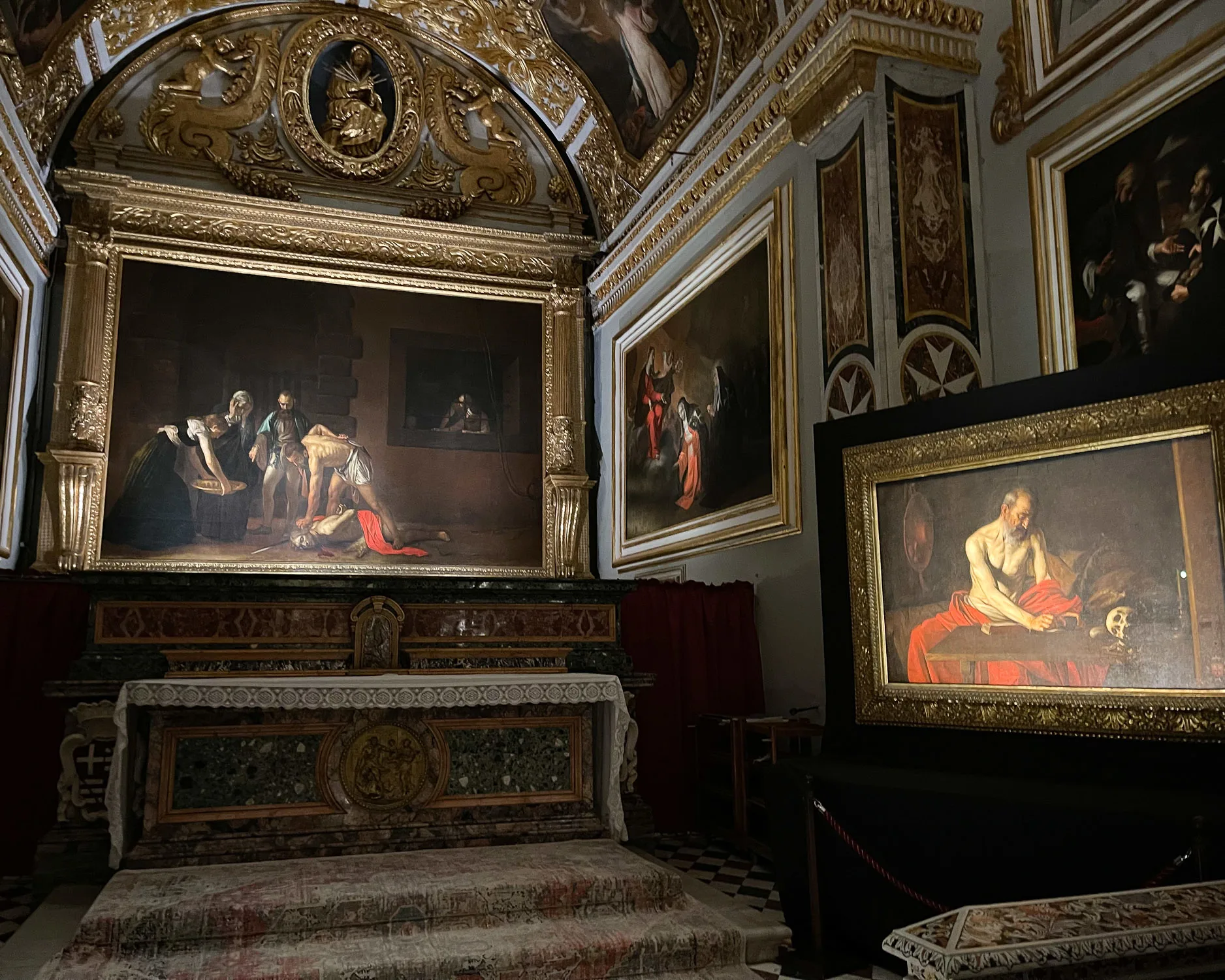
Caravaggio masterpiece in the Cathedral
In a side chapel at the back of the nave is a masterpiece by Caravaggio, depicting the beheading of John the Baptist, together with his smaller work of Saint Jerome writing. By all accounts Caravaggio had a hot temper and was prone to drinking, gambling and brawling.
Having fled Rome after killing a man, he came to an arrangement with the Grand Master to create these works, hoping that he would eventually receive a pardon from the Pope.
Best tours in Valletta Malta
If you’d like to explore more of Valletta why not choose one of tours?
Valletta 3 hour walking tour – Kick off your Valletta sightseeing with a walking tour of the city’s major sites, starting at the City Gates. Book here.
Valletta food and drink walking tour – Discover the authentic food and drink of Malta with several tasting stops as you pass the main sights of Valletta. Book here.
Valletta street food and culture tour – Learn about local food culture with tastings of sweets, street food and drinks in this walking tour around Valletta. Book here.
2. Upper Barrakka Gardens
The Upper Barrakka Gardens offer a shady respite from sightseeing in Valletta. They are probably the first place to visit if you arrive at Valletta cruise port and take the lift up from the harbour front. Originally these gardens were reserved for the private use of the Knights of Malta, but were opened to the public in 1824.

There are plentiful benches to rest among the formal flower beds with colourful plantings and central fountain. Should you want a coffee or snack there’s a kiosk cafe on one side of the gardens.

Around the edge of the gardens are colonnades leading to a terrace that overlooks the Grand Harbour. From this vantage point you’ll get some of the best views across to the Three Cities, each on its own peninsula on the opposite side of the harbour.

The Saluting Battery
Look down to the Saluting Battery on the terrace below, with the rows of cannons pointing out to sea. You can descend the steps from the garden to make a separate visit to the battery (€6). This was used to protect the harbour from attack and later to fire salutes for visiting dignitaries. The canons are fired each day at 12 noon and 4pm with much ceremony, so this is a popular time to visit the battery and watch the spectacle from the gardens above.

Bear in mind that the gardens can get very busy, especially when cruises are in port. If this is the case, there are other Valletta gardens you can visit that may be quieter, such as the Lower Barrakka Gardens or Hastings Park. From the Upper Barrakka Gardens we suggest taking the lift down to harbour level (€1 return) to find our next recommendation.
3. Take a tour of the Grand harbour
Did you know it’s not just Venice that has gondolas? From Valletta you can take one of the small Maltese wooden ferries known as Dgħajsa that criss cross the harbour. They can take you to The Three Cities (€2) or offer a tour of the harbour (€8).

We opted for the latter and got a private tour with a local boatman as our guide. He took us around the edge of the harbour and the different inlets of the Three Cities on the other side. This is one of the best things to do in Valletta for a better understanding of the harbour and a waterside view of the different fortifications.

The deep water harbour was the reason that Malta played such a central part in the history of the Mediterranean. It’s also why Malta was so intensively bombed during WW2. From 1800, the British used the Grand Harbour as their naval base in the Mediterranean. Their ships finally left Malta in 1979, an event that is remembered with much nostalgia in Valletta.
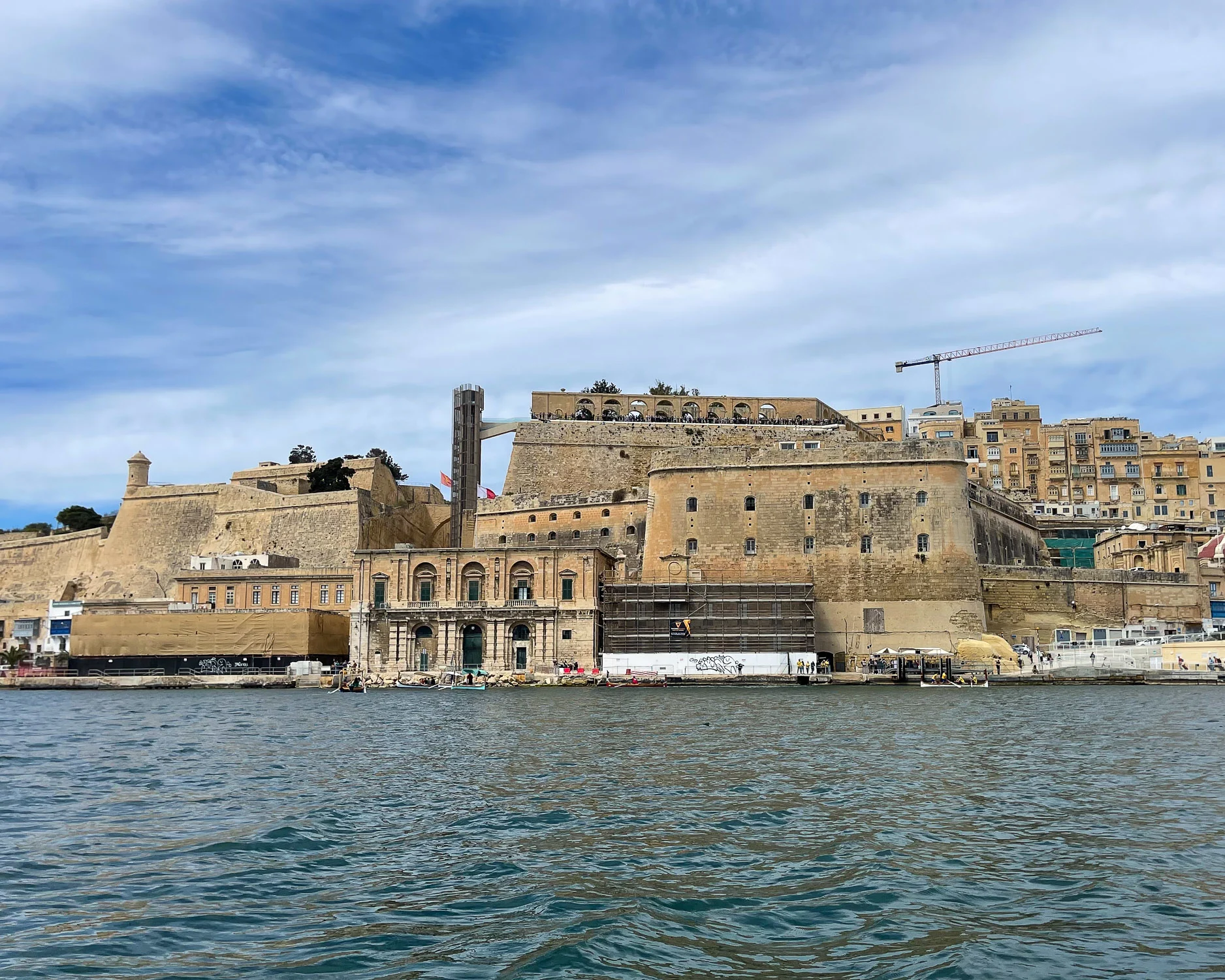
The easiest way to find the ferry point is to take the lift from the Upper Barrakka Gardens to the lower level. Then, cross the road to find the signs for the ferry departure point. While the price is fixed, each boatman operates independently. You just need to wait until one arrives and gathers enough passengers.
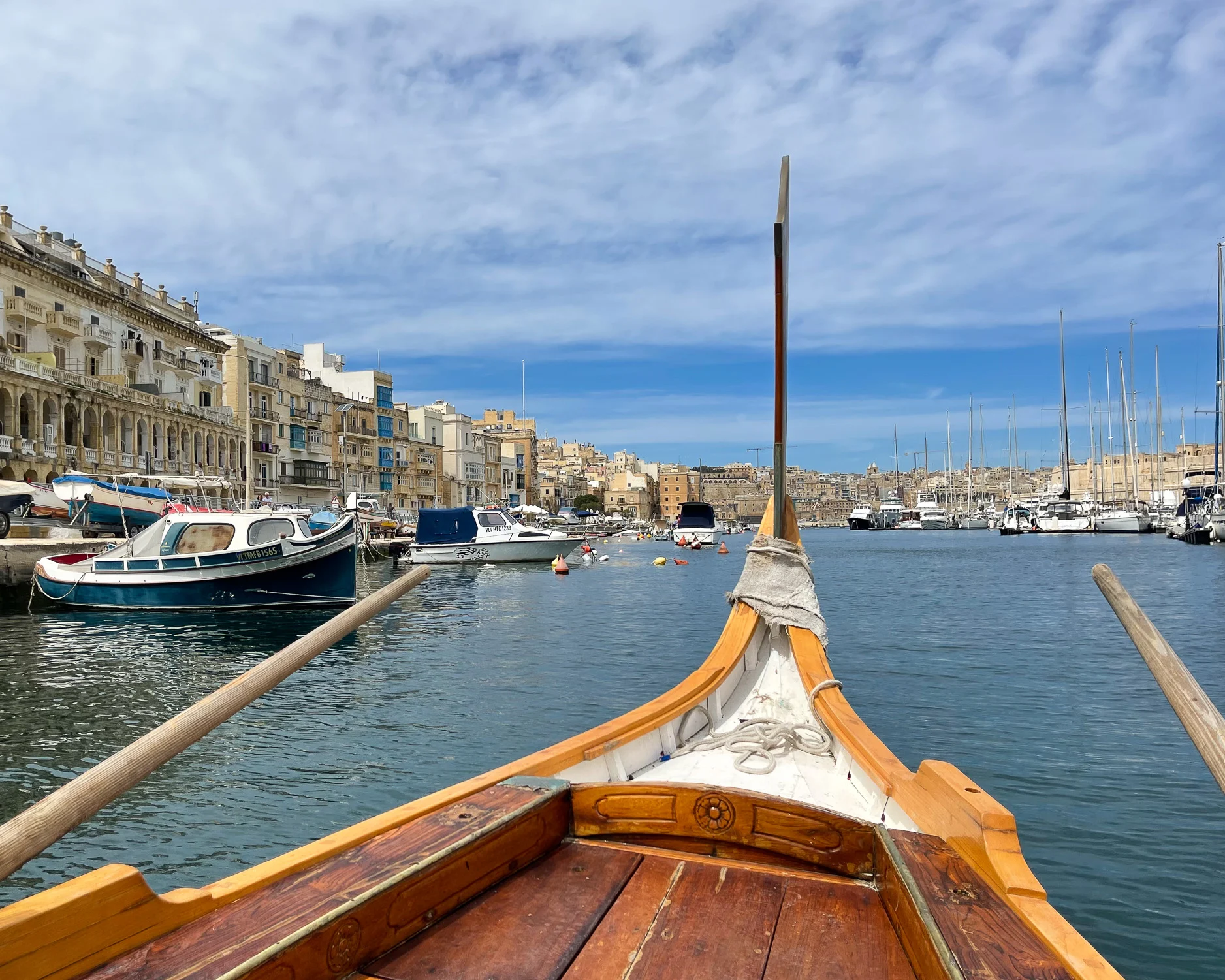
Where to find the Three Cities ferry
Tell your boatman whether you would like a harbour tour or a crossing to the Three Cities. If you take the harbour tour you can choose to get dropped back at Valletta or at Birgu on the other side. The harbour tour takes around 30 minutes but you can see a lot in quite a short time.
If you prefer to take a larger boat, there is a catamaran ferry that crosses the harbour from a little further up the quayside, dropping you on the other side, which runs every 30 minutes. (€1.50)
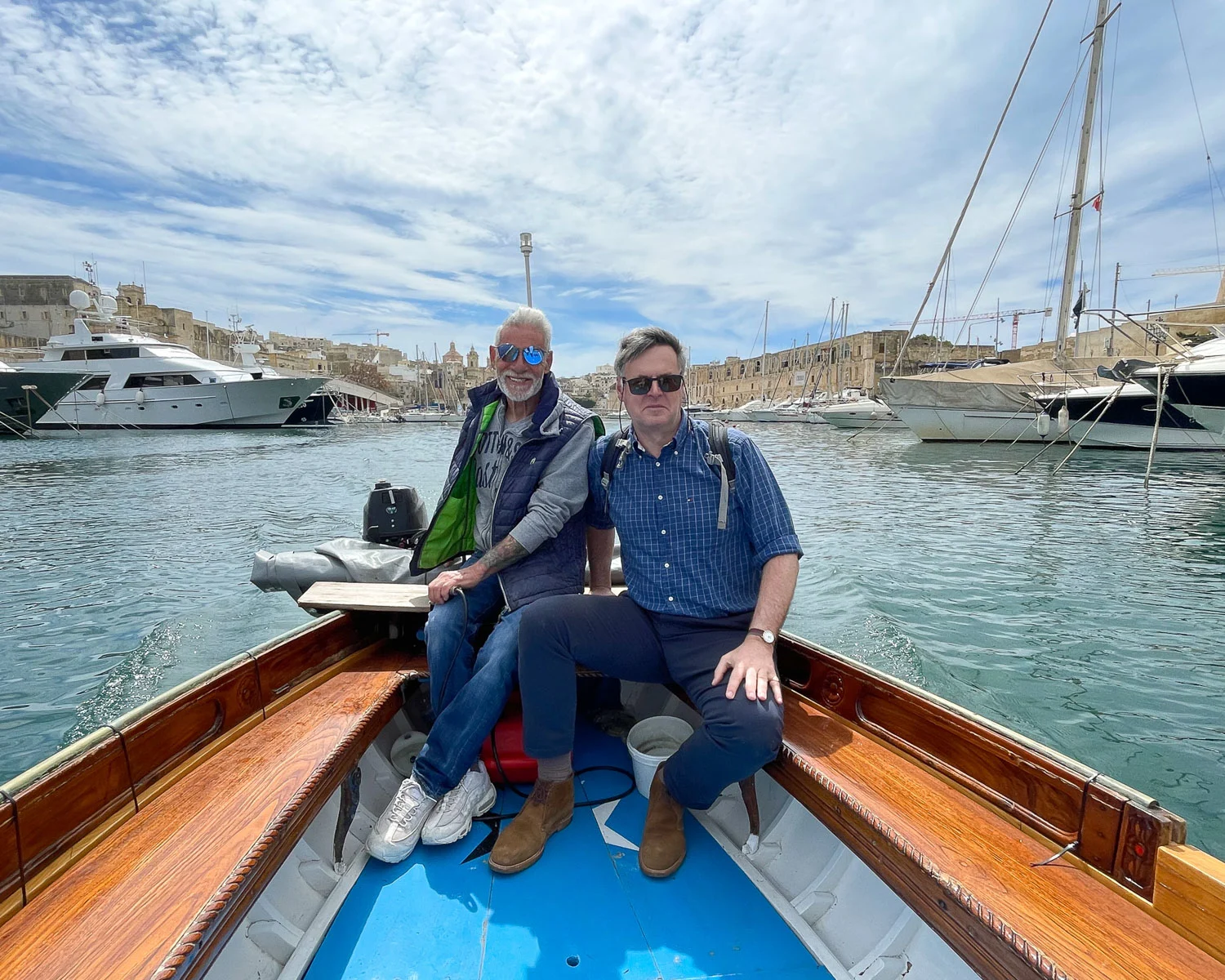

For boutique style stay at the 19th century Casa Ellul in Valletta
4. Have coffee in a Valletta square
Once you’ve visited the first few highlights that we’ve mentioned, you’ll probably be ready for a coffee or lunch break. So our next recommendation is that you settle into one Valletta’s Squares and just relax in the sun or shade (depending on the time of year) to watch the world go by.

Republic Square
This was our favourite square that’s bounded on one side by Republic Street, on the other by the Grand Master’s Palace, with the backdrop of the National Library. It’s also locally known as Pjazza Regina or Queen’s Square after the central statue of Queen Victoria that was installed in 1800.

We opted for the outdoor terrace of Caffee Cordina, an old style coffee bar that’s something of a Valletta institution. Be sure to take a look inside at the ornate interiors and check out the cakes, so you know what to order with your coffee. There’s another cafe terrace called Eddie’s Cafe Regina in the square that is more for snacks and meals.
St George’s Square
This large open square next to Republic Square is often used for festivals and events in Valletta, including the monthly changing of the guard ceremony. It’s bounded on one side by the Grand Master’s Palace which gives it the local name of Palace Square. On the opposite side is the imposing portico entrance of the Italian Cultural Institute.

When not being used for events there are benches and water fountains coming up directly from the paving, while at other times the square may look a bit bare.
There aren’t that many cafes around the square. Str.Eat Whisky and Bistro at 47 Old Theatre Street has some outdoor tables with a nice view over the square for gourmet burgers, pasta and cocktails. If you are looking for a more upscale experience, try 59 Republic. It’s a Michelin awarded restaurant with a terrace directly on the square for lunch or dinner.
St John’s Square
Opposite the main entrance of St John’s co-cathedral (which is where you exit when visiting) is the pretty St John’s Square, surrounded by colonnades. There are two cafe terraces here on either side of the central statue of Enrico Mizzi, former Prime Minister of Malta. The more popular is San Giovanni, a Mediterranean restaurant that serves meals throughout the day and cocktails in the evening.

While you are here, you might want to pop into the Souvenirs That Don’t Suck gift shop selling trendy Malta souvenirs. Under the arcade is Manouche Craft Bakery for breakfast pancakes or coffee, with a couple of tables outside.
Continuing down Triq San Gwan towards Merchants Street there is another shady cafe under the trees called Luciano’s that serves from a traditional green kiosk on the corner with Merchant Street.
Gardens in Valletta for coffee
If you fancy a coffee in one of the gardens in Valletta, there are a few to choose from, depending on which part of the city you are in.
Close to the city gate is Hastings Park, which is much less visited than the Upper Barrakka Gardens and has a small coffee kiosk. Despite being so close to some tourist hotspots, we found the garden quiet when we visited and as a bonus you have some great views from the bastion walls.

The popular Upper Barrakka Gardens has a kiosk for coffee and cake or drinks, with great views over the Grand Harbour. At the northern tip of Valletta, the Lower Barrakka Gardens is close to Fort St Elmo and the Malta Experience and has a couple of cafes at its entrance.
Picnic spots in Valletta
If you are looking for a picnic spot, we suggest picking up some local delicacies in the Valletta Market Is-Suq Tal-Belt where there’s a supermarket on the lower level, then head to any of the parks. Alternatively stop at Malta Pastizzi (Manuela) at 57 Merchants Street to buy Malta’s favourite (and cheap) pastizzi snacks, a small pie of flaky pastry with a ricotta or pea filling.
Another less known garden for a picnic is the Laparelli Garden in the Valletta Ditch or moat that you can see when you walk over the City Gate bridge. It’s accessible via a lift or stairs that are right by the Parliament Building.
Tours in Valletta Malta
If you’d like a guided tour in Valletta why not choose one of these
Valletta 3 hour walking tour – Start your Valletta sightseeing with a walking tour of the city’s major sites, starting at the City Gates. Book here.
Valletta food and drink walking tour – Discover the authentic food and drink of Malta with several tasting stops as you pass the main sights of Valletta. Book here.
Valletta street food and culture tour – Learn about local food culture with tastings of sweets, street food and drinks in this walking tour around Valletta. Book here.
5. Casa Rocca Piccolo
Once you’ve had a bit of a break for lunch or a snack, there are a couple more highlights that you can probably fit in during the afternoon. It’s perhaps a challenge to do both of these next places to visit in Valletta in just one day. So we’d recommend choosing between Casa Rocco Piccolo for culture lovers or Fort St Angelo if you want to uncover Malta’s fascinating military history.

If you’ve been wandering the streets of Valletta, wondering what’s behind the elegant facades, now’s your chance to explore a 16th century palace that still has the feel of a family home.
The Casa Rocca Piccolo on Merchants Street is open until 5pm with last entry at 4pm. Guided tours take place in English on the hour. There’s also an audioguide that you access via a smartphone app in other languages. This means that you can arrive at any time for a self guided tour.

A tour of Casa Rocca Piccola
The tour starts in the pretty courtyard where you can say hello to Kiku the pet parrot. Then climb the elegant marble staircase to visit a succession of sumptuous rooms. Colour is everywhere, in the vibrant shades of lilac, green, ochre and crimson on the walls and traditional patterned Maltese tiles on the floor.

It goes without saying that each room is packed full of antiques, paintings and collections of the past owners. It shows how a Maltese noble family might have lived in the past couple of centuries. We especially loved the pretty light filled dining room, with windows overlooking the courtyard and table laid for a celebration meal.

A fascinating end to the tour was a visit to the old water cisterns underneath the house. These were converted into air raid shelters for use during WW2. When the Knights of Malta laid out Valletta as a new city in 1566 they required that every house should have an underground water cistern. This was to collect precious rainwater and ensure that the city could withstand any future siege.
You can also stay in some of the historic bedrooms at Casa Roca, with access to visit the whole Palazzo.

Stay at the historic Casa Rocca Piccola B&B in a 16th century palazzo in Valletta
6. Fort St Angelo
Located at the northern tip of Valletta peninsula, Fort St Angelo is a medieval castle that was rebuilt as a star shaped fort in the 1550s by the Order of St John. The fort played a central role in defending Malta against Ottoman attack during the Great Siege of 1565. Later, the British used Fort St Elmo as their main garrison until the final departure of their navy in 1979.

Fort St Angelo has now been restored and is the home to Malta’s National War Museum, which is located within the inner part of the fort. As there’s so much to see, and the outer walls can be quite exposed in hot weather, we’d recommend that you head straight into the museum part of the fort and look at the outer defences on your way out if there’s time.
National War Museum of Malta
In a series of numbered rooms, the museum tells the story of Malta’s military history from the Medieval period and the Knights of Malta to the Second World War and beyond. Many of the rooms have short videos or audiovisual displays that bring to life key events such as the Great Siege of Malta in 1565.

In the final rooms are artefacts, uniforms and vehicles from the most recent conflict in World War 2. These include the George Cross that was awarded collectively to the people of Malta for their bravery and endurance during the intense bombardments of WW2.

As you walk between the different display rooms there are chances to look out from the fortifications over the Grand Harbour and other parts of the fortress. There’s a lot to see in the fort and museum, so you should allow at least a couple of hours. Otherwise head straight to the parts of the museum that will interest you most.
After your visit, the Lower Barrakka Gardens are a shady place to relax and grab a drink at one of the cafes by the garden entrance.
7. Grand Master’s Palace
The Grand Master’s Palace is one of the top things to see in Valletta. It reopened in January 2024 following an extensive renovation. The palace was built for the elected leader (Grand Master) of the Knights of Saint John. It is now the official residence of Malta’s President. Visitors can see five of the palace’s state rooms and the armoury.

Best tours in Valletta Malta
If you’d like a guided tour in Valletta why not choose one of these
Valletta 3 hour walking tour – Kick off your Valletta sightseeing with a walking tour of the city’s major sites, starting at the City Gates. Book here.
Valletta food and drink walking tour – Discover the authentic food and drink of Malta with several tasting stops as you pass the main sights of Valletta. Book here.
Valletta street food and culture tour – Learn about local food culture with tastings of sweets, street food and drinks in this walking tour around Valletta. Book here.
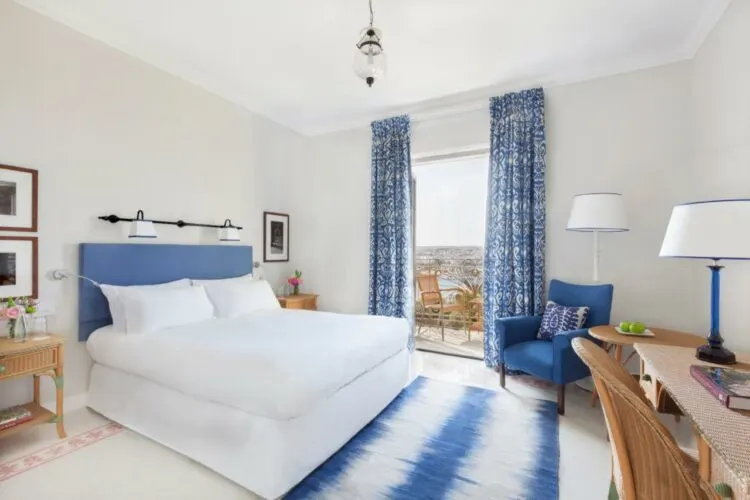
For a luxurious hotel stay at The Phoenicia, the most historic of luxury Valletta hotels
More things to see in Valletta – around the City Gate
Now we’ve covered what to do in Valletta in one day, let’s look at what else to see if you have time. Whether you want to picnic in a shady garden, visit an art gallery, peek inside a stunning Palazzo or dip into Malta’s WW2 history, there’s something for you. I’ve arranged these Valletta attractions by area, so that you can easily visit a few places that are close to each other.
8. City Gate and Parliament Building
If arriving by bus to Valletta, your entrance is likely to be via the City Gate. A bridge crossing the deep moat or Valletta Ditch has been here since the 16th century. The present gate was designed by architect Renzo Piano in 2011. Also part of his design is the Parliament Building, the first building you see on your right on entering the city.

The uncompromisingly modern design was controversial at the time of construction. But, being made of the same limestone as the rest of the city it blends in surprisingly well with older buildings nearby.
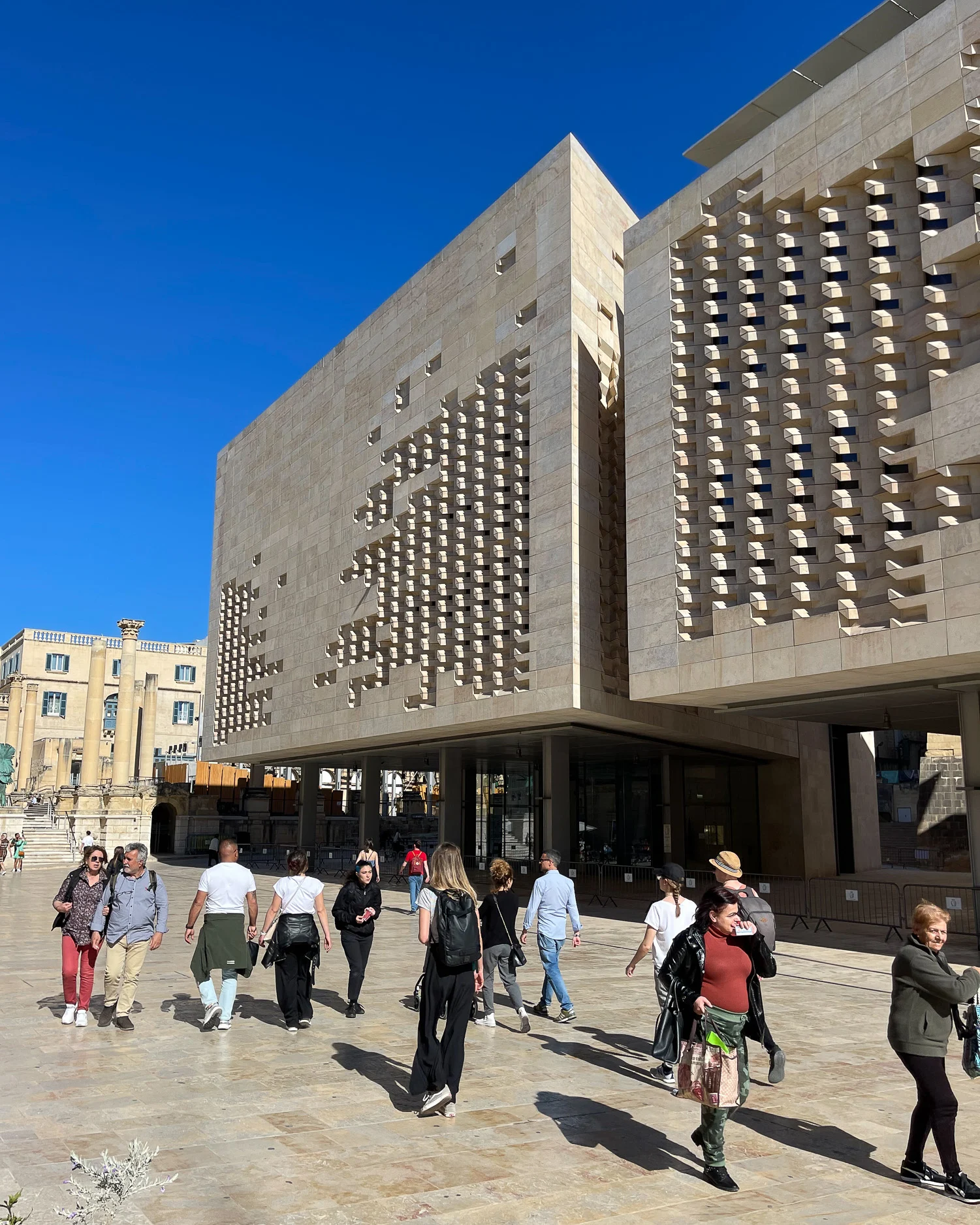
Pillars supporting the building allow it to float above the plaza. Angled stones on the front and sides mean that the locals refer to it as the “cheese grater”.

Immediately outside the City Gate is an open plaza with the Triton Fountain. This is a local landmark and meeting place, which is pretty to see at night when illuminated with coloured lights.

9. Valletta Ditch and Francesco Laparelli Gardens
Crossing the bridge of the City Gate, you may look down and see the deep moat that surrounds the fortifications at the entrance to Valletta. Known as the Valletta Ditch, the plan was that during times of attack, the ditch could be flooded by letting in water from the harbour on either side.


In recent years the ditch was an unsightly car park until it was restored and a garden made in the most visible section below the city gate. The Francesco Laparelli Gardens are named after the architect who designed Valletta in 1566. They make a quiet, green oasis away from the bustle of the city and bus station above.
You can reach the gardens by a lift and stairway beside the Parliament Building.
10. Hastings Garden in Valletta
Another garden in Valletta that’s worth visiting, especially if you need a quieter alternative to the Upper Barrakka Gardens, is the Hastings Garden. Look up on the west side of the city gate and you’ll see it starting at the end of the bastion and running all the way along the top of the ramparts.

The garden is named after Lord Hastings who was Governor of Malta. He was buried here in 1826 within a classical stone monument. All along the top of St John’s Bastion are gravel walks, flowerbeds and trees. Gardens continuing around the corner on St Michael’s Bastion. You’ll get fantastic views over the City Gate at one end and Marsamxett Harbour at the other, looking towards Manoel Island and Sliema.

We enjoyed this shady garden as a quiet retreat from the bustle in the square below. There’s a small kiosk cafe where you can order a coffee or drink.
11. Royal Opera House
Once you’ve crossed the City Gate, a short walk along Republic Street past the Parliament Building brings you to the site of the Royal Opera House. Built in 1866 in neo-classical style, the Opera House was one of the most imposing buildings in Valletta.

Sadly the building received a direct hit during the aerial bombardment of Valletta in WW2 and lay in ruins for many years. Finally, the site was partially restored as an outdoor theatre space incorporating some of the remaining columns.
As Pjazza Theatru Rjal it hosts musical events throughout the year, but is still regarded as a monument to the endurance and resistance of the Maltese people during World War 2.
12. Auberge de Castile
If you turn along either side of the Royal Opera House, a short walk up hill brings you to the Auberge de Castile, with cannons flanking the entrance. This was one of a number of ‘Auberges’ in Valletta. Literally they are ‘Inns’ that were used by different branches or ‘langues’ of the Knights of Malta, depending on which country or region they were originally from.

A sort of 16th century gentleman’s club combined with place of business, the Auberges acted as luxurious headquarters and accommodation. The baroque style Auberge de Castille is not open to the public. It’s used as the office of the Prime Minister of Malta, with the plaza in front used for public events.
13. Art in Valletta – MUZA and Spazju Kreativv
If you enjoy art, there are a couple of places you might want to stop nearby. Both are in beautiful historic buildings that are worth a look in their own right. If you are facing the Auberge de Castille, walk down Merchants Street on the left side and you’ll immediately find MUSA, Malta’s National Museum of Art.
The art museum is housed in another of Valletta’s historic Auberge, the Auberge d’Italie. Even if you don’t plan to visit the museum, enter the doorway to see the impressive courtyard with its central well that is also used as a cafe. MUSA houses paintings and sculptures from Medieval times up to the late 19th century. They’re arranged by different themes, but unified in their connection with Malta and its history.
Also in the same square as the Auberge de Castille is Spazju Kreativv (Creative Space), a cultural centre and arts cinema, housed in the 16th Century Fort of St James.
14. National Museum of Archaeology
Just to complete our tour of Malta’s top museums, a couple of blocks away is the National Museum of Archaeology. It’s located on Republic Street, Valletta’s main thoroughfare. The museum is in another of Valletta’s historic Auberge, this time the Auberge de Provence.
Look out for original painted walls and ceiling from the 1800s in the Gran Salon on the first floor. Artefacts on display here date from Malta’s Neolithic period up to the Phoenicians who dominate the Mediterranean in the 8th century BC.
If you’ve visited any of the neolithic temples on Gozo or Malta, this is where you can take a look at their archaeological treasures. These include curvaceous fertility goddess statues such as the “Sleeping Lady” from the Hypogeum of Ħal Saflieni.
Read about 13 fun things to do in Gozo
Things to do in Valletta – along the Grand Harbour
15. Valletta waterfront – Pinto’s Wharf
If you arrive by cruise ship, your first sight of Valletta is likely to be Pinto’s Wharf, now known as the Valletta Waterfront. Honey stone storehouses lining the waterfront were named after Grandmaster Emanuel Pinto de Fonseca, who ordered them to be built in 1752.

The coloured doors of each warehouse denotes what they were originally used to store: blue for fish, yellow for wheat, red for wine, green for agricultural products. Pinto’s Stores, as they are known, have been renovated to make a leisure destination. This is aimed especially at cruise visitors but open for all.
There’s a great choice of waterfront Valletta restaurants and shops, with outdoor terraces that overlook the harbour. From here it’s an easy walk along the waterfront promenade and road past Valletta port to reach Lascaris Water taxi station. Nearby take the lift up to the Upper Barrakka Gardens (which is covered earlier in the article).
16. Boat trips and tours from Valletta
If you’d like to take a boat trip around the harbour or further afield there are a few different options that start in Valletta, especially from Lascaris Wharf.
Gondola ride to Three Cities or Harbour Tour. We recommended earlier in the article using the Dgħajsa water taxis to take an inexpensive harbour tour (€8) or to cross the harbour to the Three Cities (€2)
Catamaran ferry across the harbour to Three Cities – This leaves around every 30 minutes from Lascaris Wharf to cross to the Three Cities (€1.50)
Fast Ferry to Gozo – These leave throughout the day from Lascaris Wharf. The journey takes around 45 minutes. Tickets can be purchased online in advance or from the ticket booth on the quay.
Ferry to Sliema – The ferry to Sliema (€1.50) starts from the other side of Valletta to the Grand Harbour. However, you can easily take the lift to the Upper Barrakka Gardens and then walk across the peninsular to the ferry point at Boat Street. The walking time is around 15 minutes. At Sliema there are lots of bars and restaurants, with a pleasant promenade along the coast.
17. Lascaris War Rooms
If you are interested in Malta’s WW2 history, Lascaris War Rooms is an excellent small museum. It’s quicker to visit than the National War Museum at Fort St Elmo. The underground tunnels and chambers within the city’s fortifications formed a secret Headquarters for the Allied command in Malta during World War 2.

From here all air and sea operations were controlled, with war rooms and maps plotting the movements of ships and aircraft. You can visit using an audioguide, or on one of the regular guided tours to learn more of the history of Malta in World War 2. View displays of artefacts and the original maps and war room tables.
The entrance to the Lascaris War Rooms is just below the Upper Barrakka Gardens (mentioned earlier in the article). There’s a passage leading to it from the road by the cruise port.

18. Victoria Gate
Just a short walk from Lascaris Wharf where the ferries leave, is the impressive Victoria Gate. Built by the British in 1885 on the site of an older gate, it was named after Queen Victoria. This Gate was once the main entrance from the Grand Harbour through the fortified walls and into the city.

If you want to continue your walk along the harbour front, pass through Victoria Gate and climb the steps behind, to reach St Barbara’s Bastion. Here you can walk along the tree lined road past some of the most beautiful townhouses in Valletta. View their painted balconies and views over the harbour.
18. Swimming in the harbour – Wuestenwinds Beach
As you walk along St Barbara’s Bastion in the direction of the Lower Barrakka Gardens, you may notice a rocky stretch of waterfront with small huts that hug the harbour wall. This is Wuestenwinds Beach, the only place that you can easily swim within Valletta’s harbour.

Steps take you down to a rocky shore that is popular with sunbathers. The huts were traditionally used by fisherman, but some have been taken over by local families as beach huts. Given that this is a busy harbour I’m not sure I’d want to swim here. But, it could be a place to escape the city for sunbathing and relaxation.
19. Lower Barrakka Gardens
Our walk continues to the Lower Barrakka Gardens, a smaller version of the Upper Barrakka Gardens. There’s a pretty classical monument, shady trees and plenty of benches to take in the view of the Grand Harbour. From the colonnaded terrace there’s a prime view over the Siege Bell War memorial, which is also worth a visit.

There are two different cafes at the entrance to the gardens, both of which do food and drinks. This is a pleasant place to visit at sunset for an aperitif. For lunch we enjoyed some excellent seafood pasta at the friendly neighbourhood Sicilian restaurant Valletta St Paul’s AFT that’s just down the hill.

20. Siege Bell War Memorial
Just below the Lower Barrakka Gardens is the Siege Bell War Memorial. This commemorates those who lost their lives during the siege of Malta during World War 2. During the war Valletta suffered under continuous aerial bombardment. By the first half of 1942, Malta was brought to the brink of starvation, since only two merchant ships managed to arrive that year with supplies.

Finally the Merchant Navy launched Operation Pedestal, sending a large convoy of supply ships. Only 5 managed to limp into the Grand Harbour, saving Malta from disaster. The Bell that’s housed within the monument is rung each day at noon. This is to commemorate those who lost their lives in this operation and in the three year siege of Malta during WW2.

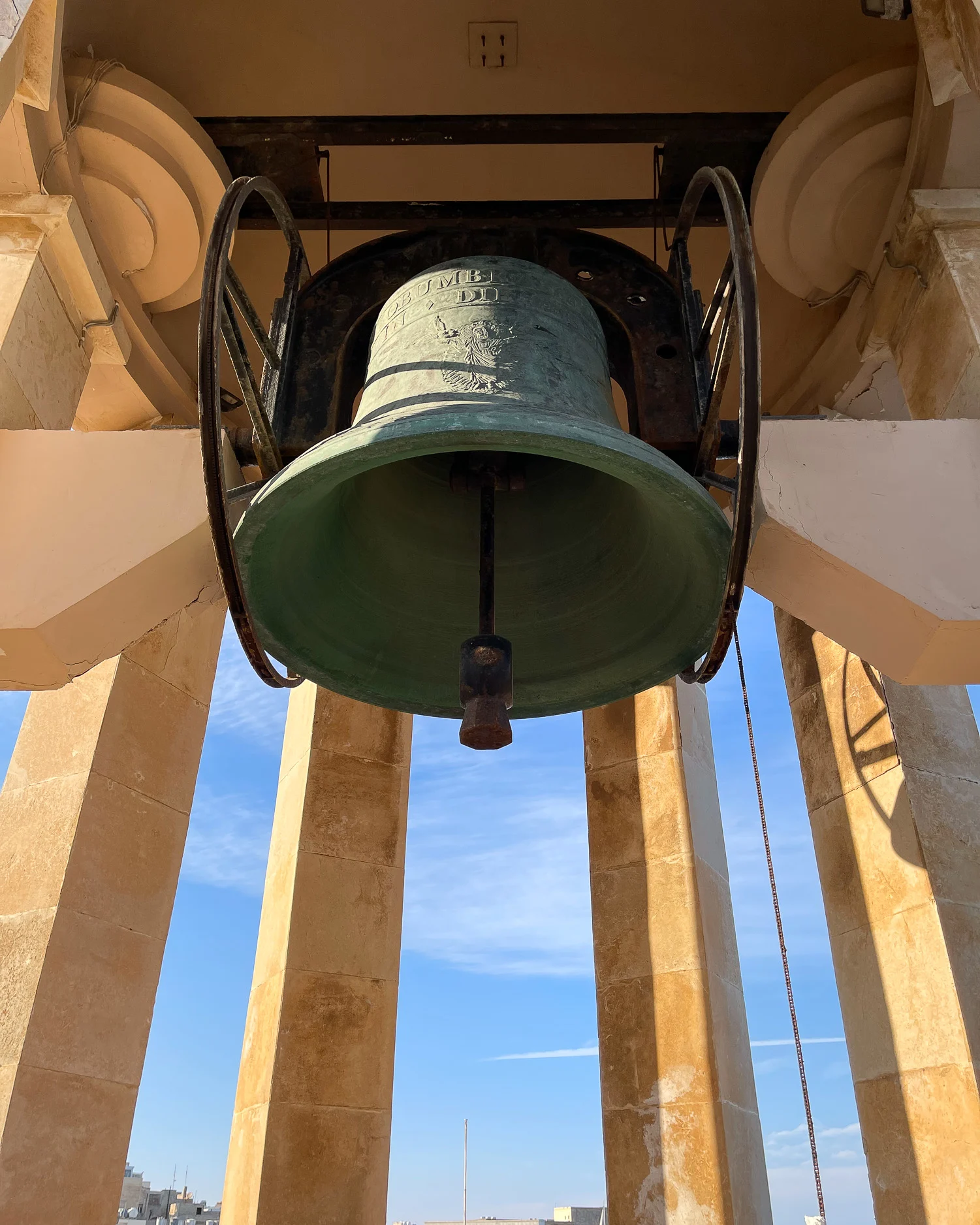
21. The Malta Experience and Sacre Infermeria
Close to the Lower Barrakka Gardens by Fort St Elmo, at the northern tip of Valletta, The Malta Experience is an audio visual show that tells the story of Malta’s dramatic 7000 year old history.
The 45 minute show covers Malta from prehistoric times, the shipwreck of St Paul bringing christianity, the Knights of Malta and the second siege of Malta during WW2. We didn’t have time to see the show, but if you are interested in history, it will add context to many of the other places you visit in Valletta.
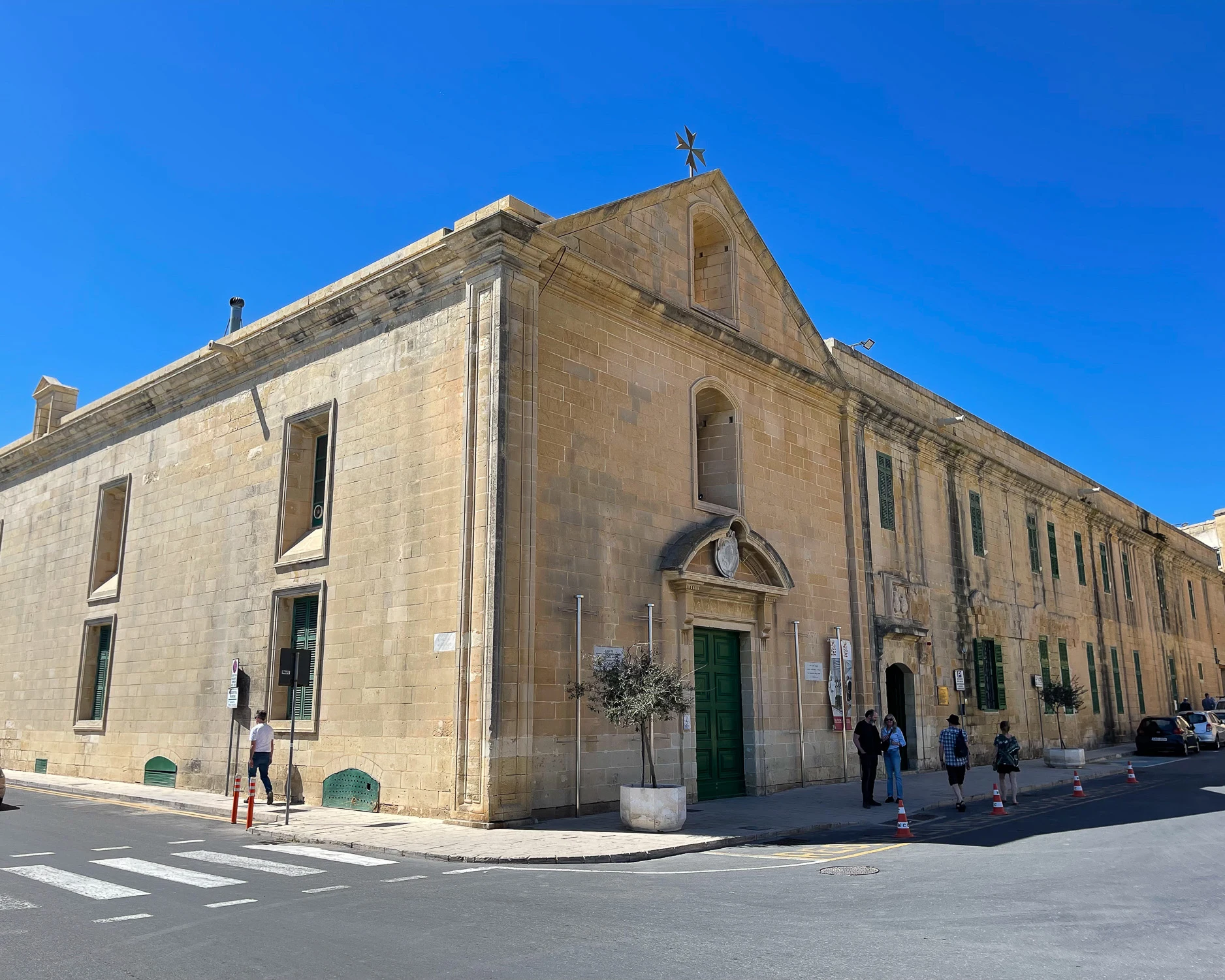
Included in the ticket is a visit to the Sacre Infermeria, which is located just across the road from the Malta Experience. The origins of the Knights of Malta were in their care for sick pilgrims. The Sacra Infermeria (Holy Infirmary) was their main hospital in Malta.
The building has now been repurposed as The Mediterranean Conference Centre. We attended a dinner in The Grand Magazine Ward, which you can visit on the 30 minute tour.


More to see on the west side of Valletta
If you are in Valletta for a few days, you may like to visit a few more attractions that are located in the central / west side of Valletta, closer to the Marsamxett Harbour.
22. Manuelo Theatre
This ornately decorated 18th century theatre puts on regular performances, but you can also visit on regular tours. The Manuelo Theatre was built by Grand Master António Manoel de Vilhena in 1731, as a place to provide honest entertainment for the general people and not just the nobility.
Manuelo theatre is a masterpiece of the Baroque with gorgeous gilding and painted panels. Tours take place most days except Sunday. When we visited they were reduced due to renovation work, so check the website for details, then stop by at the theatre to check.
23. Mysterium Fidei Museum
Close to the Manuelo Theatre an inconspicuous doorway opens to the Mysterium Fidei Museum, in St Catherine’s Monastery. It was founded in 1575 to take care of female orphans, home to an order of cloistered nuns. The stone that was used to build the monastery was quarried from the rock below. This created some underground spaces that you can visit using an audio guide app on your mobile phone.

Also to visit are the cloisters and hidden internal garden. We were not able to visit ourselves, but it sounded a fascinating place to understand the life of a working convent, behind the inscrutable closed doors of Valletta’s streets.
24. Underground Valletta Tour
This was one tour that I was really keen to take but sadly the timings didn’t work out. The Underground Valletta Tour must be pre-booked through the Heritage Malta website. It takes you under the city to explore the tunnels and spaces beneath the streets of Valletta.
When the city of was laid out in the 1560s, rock was quarried on site to create the magnificent buildings. Eac was built with its own water cisterns to collect precious rainwater. Underground tunnels allowed the movement of soldiers. Grain storage cellars ensured that the city could be self sufficient in peace and in war.

During the intensive aerial bombardment of WW2, the population of Valletta moved underground. They extended and connected cellars, cisterns and tunnels as a place of refuge. The tour of these underground tunnels starts at The Museum of Archaeology and lasts around 1 hour.
Where to eat in Valletta
You won’t be short of places to eat in Valletta, as the city is packed full or bars, restaurants and cafes. I’ll mention a few of the best restaurants in Valletta, that we enjoyed or heard good things about.

Valletta Food Market – Is-Suq Tal-Bet – for street food
This old food market has been renovated and transformed into a street food dining venue. The main hall is lined with stalls selling every different type of cuisine, from pasta and pizza to Maltese specialties and Asian dishes.
Downstairs is a supermarket which is ideal for shopping if you are self-catering. The upper floors house larger restaurants. This is a great place for cheap eats if you are on a budget or are dining with friends and family who have different tastes.

Merchants Street – for lots of restaurant choices
Merchants Street is a pedestrianised street that’s lined with many different restaurants and becomes especially lively in the evening. It’s a bit touristy but there’s loads of choice and probably it’s the best place to head if there’s a group of you.
Much of the seating is outside on the street itself, which gives it lots of atmosphere in the warmer months. If it feels too noisy and busy for your taste, check some of the side streets that run off Merchant Street.

St Lucia Street – for that instagram moment
Anyone looking for the perfect Instagram photo should look no further than St Lucia Street. It’s a side street that branches off from Merchant Street with steps down to the harbour. Most of the restaurants manage to improbably balance their chairs and tables on the steps outside.

Add in some pot plants and hanging chandeliers and the atmosphere is quite charming. While I’m not sure I’d want to balance my dining chair on a narrow step, it seemed very popular with the younger crowd.
Strait Street – for trendy cocktails
In the days when Malta was a British Naval Base, Strait Street was the sailor’s drinking hole. Officers would socialise at the upper end of the street. The lower end, known as The Gut, had a seedy reputation and doubled as the Red Light District.


These days Strait street has reinvented itself as a trendy nightlife spot with numerous cocktail bars and small restaurants. We enjoyed cocktails and tasty Maltese sharing dishes at Tico Tico (61 Strait Street) and heard good things about Yard 32 (32 Strait Street), a gin and tapas bar. Look out for the atmospheric old bar signs that still hang on buildings above the street.
Coffee Stops in Valletta
I’ve already mentioned coffee options such as Caffee Cordina in Valletta’s squares around St John’s co-cathedral. These are perhaps not the cheapest but are great for people watching. Parks such as Upper Barrakka Gardens, Lower Barrakka Gardens and Hastings Gardens also have coffee kiosks which are a relaxing place to stop.
If you are looking for more of a European style coffee / brunch / cake experience head to Sunday in Scotland (173, Santa Lucia Street). For barista style coffee go to Lot 61 (30, Old Theatre Street).
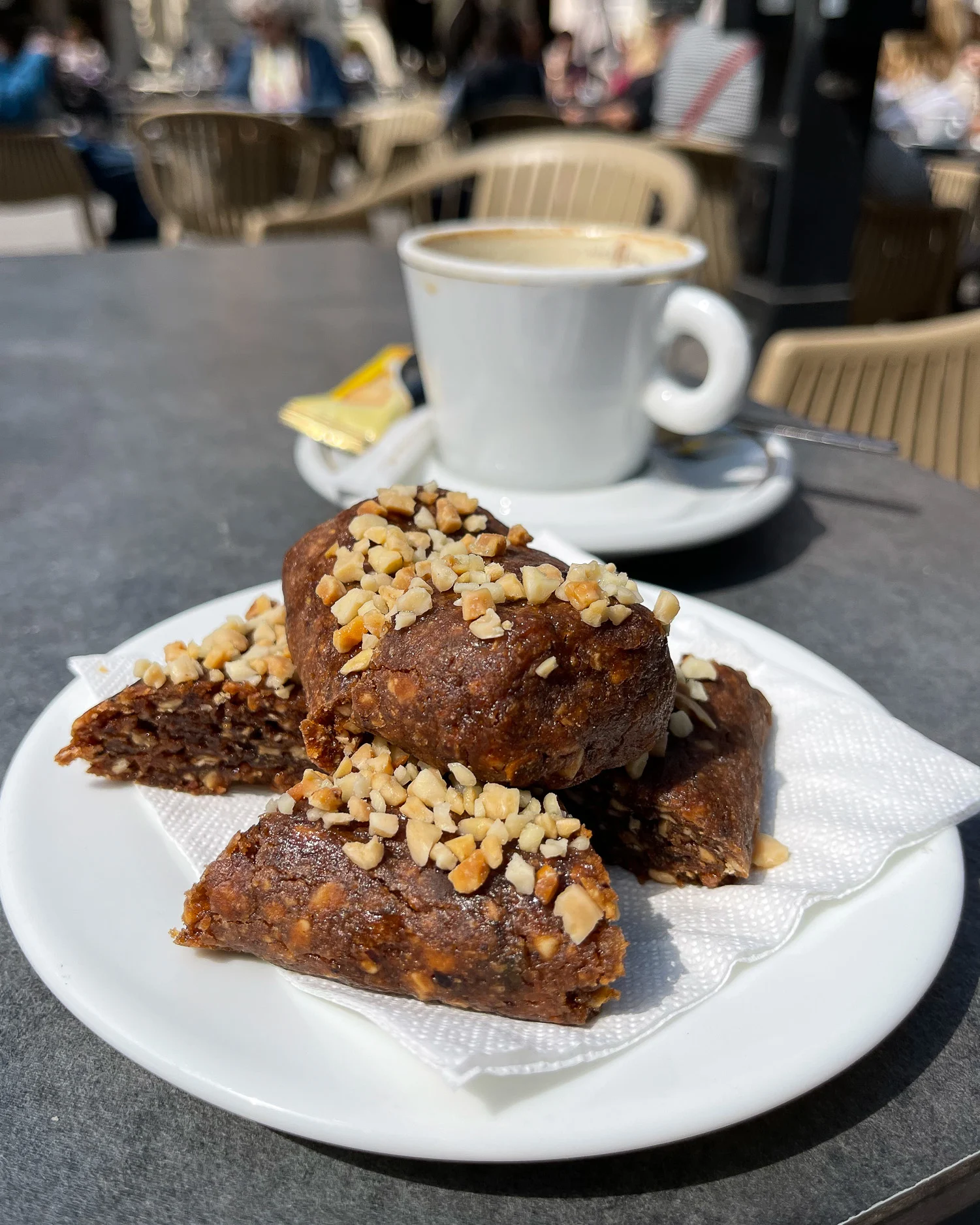
Vegan / Vegetarian restaurants in Valletta
Looking for vegan or vegetarian restaurants in Valletta? We recommend the following for a healthy salad fix.
Soul Food – (76 Merchants Street) A small cafe / restaurant with a pretty outdoor seating area just off Merchants Street. They serve Buddha Bowls, salads, pasta dishes and vegan burgers, with fruit juices and smoothies.
No 43 – (43 Merchants Street) A small cafe that’s known for its colourful salads and sandwiches to take away or eat on the tables outside.
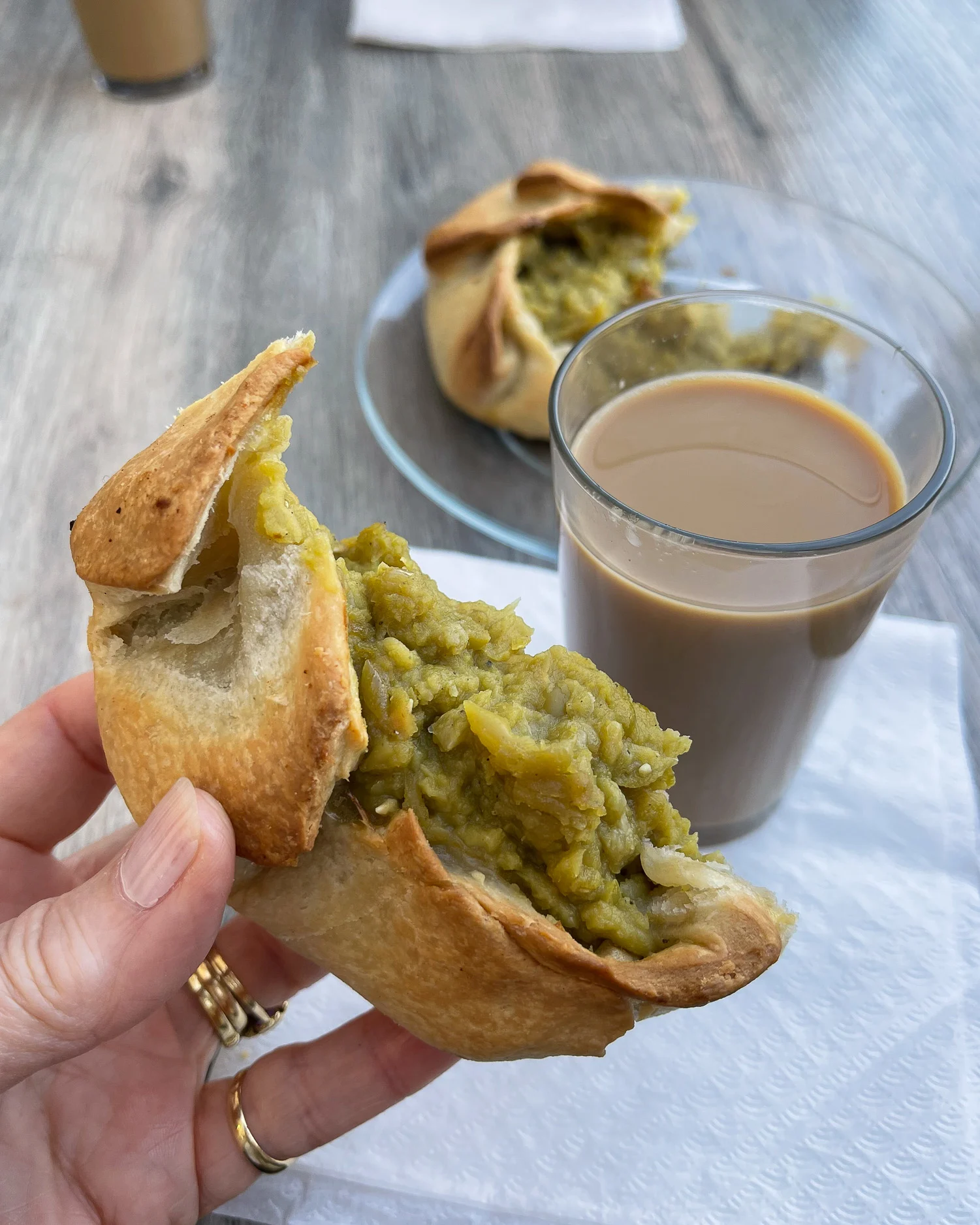
Maltese cuisine in Valletta
Perhaps you had your fill of pastizzi in the day but want to try some more traditional dishes in the evening? For traditional Maltese fare – slow cooked rabbit, beef olives, Aljotta fish soup or Ftira Maltese pizza, head to Nenu the Artisan baker (143 St Dominic Street). They don’t have any outside tables, but this would be an atmospheric place to dine on cooler evenings.

Fine Dining in Valletta
If you want a more upscale or gourmet experience, here are a couple of restaurants that were recommended to us, both in the Michelin Guide.
59 Republic – With an outdoor terrace on St George’s Square opposite the Grand Master’s Palace, this is one of the best restaurants in Valletta, located in the heart of the city. The a la carte menu changes every 8 weeks and features fresh, seasonal dishes and innovative flavours. There’s also a nice choice of light bites to share with a drink.
ION Harbour by Simon Rogan – Dine at the Mediterranean outpost of the Simon Rogan empire which includes restaurants in London and Hong Kong. Located on the rooftop terrace of the elegant 5 star Iniala Harbour House Hotel. This is one of the best Valletta restaurants with a view over the harbour. In the evenings expect a multi-course tasting menu that focusses on hyper-local ingredients, foraged, fished or farmed in Malta. On weekday lunchtimes a simpler set menu is served.

Best time to visit Valletta
Malta is located very close to the southern shores of Sicily and enjoys year round sunshine and hot summers. The ideal time to visit for sightseeing is Spring (March – May) and Autumn (September – November), when the days are warm and sunny but not unbearably hot.

Personally I would avoid visiting in the heat of the summer – July, August and even parts of June and September – unless you are visiting Malta for a beach holiday and want to visit Valletta on a day trip.
December, January and February bring rain but the winter is mild and you can still get sunny days. However you may not get the best of Malta’s Mediterranean climate in winter.
We visited in March and enjoyed the warmth and sunshine at a time when northern Europe can be cold and wet.
Best Day trips from Valletta
Three Cities
The Three Cities are the name given to the towns and fortifications that lie just across the Grand Harbour from Valletta. They are located on three different fingers of land that provide sheltered harbours between them. Each have two names that are used interchangeably, the original old Maltese name and the newer name given to them by the Knights of Malta who established their first base there.

Birgu (Vittoriosa) is the oldest and was build up by the Knights of Malta as their headquarters when they arrived on Malta in 1530. Senglea (Isla) gives more of a local experience with few formal sights. Bormla (Conspicua) is set back behind these peninsulas. Also jutting into the harbour is the peninsula of Kalkara, which can be seen from across the marina from Birgu.

A visit to the Three Cities makes a pleasant day to walk around and admire the old buildings. Have a drink or lunch on the quayside and visit a couple of museums. The Valletta 3 Cities Ferry is an inexpensive way to cross the harbour on a catamaran from Lascaris Wharf. A more atmospheric crossing is on one of the old wooden Dgħajsa boats that go from the same location on the Valletta side.
Read more in my article on: A guide to the Three Cities Malta – top things to do
Gozo from Valletta
Although the main car ferry runs from Cirkewwa in the north of Malta, there’s also a passenger only fast ferry from Valletta to Gozo. In 45 minutes you’ll arrive in Gozo, where there are numerous ways to get around the island and see a few things in a day trip.
Read more in my article on: 13 fun things to do in Gozo

Options for getting around include the public buses, hop on hop off bus, tuk tuk tours. Try a private taxi tour, quad bikes or hiring a car for the day (we tried the last option). The Valletta to Gozo ferry runs about once an hour throughout the day. You can easily book online or at the Lascaris Quay ticket booth where it departs. Depending on what interests you most and what transport you use, things to see in Gozo include;

Best things to do in Gozo
- Gozo’s capital Victoria and medieval citadel
- The Ggantija Neolithic Temples
- Dwejra inland sea and short boat trip to the sea caves
- Ramla Beach and the Tal-Mixta Cave viewpoint
- The salt pans along the north coast near Marsalforn
- Swimming in rocky inlets like Wied il-Ghasri on the north coast or Mgarr ix-Xini on the south coast
Read more in my article on: 13 fun things to do in Gozo
Check out these Gozo Tour options
Gozo full day Tuk Tuk tour and lunch with driver
Gozo self drive e-jeep guided tour
M’Dina and Rabat
The walled medieval city of M’Dina was Malta’s first capital, with Rabat the newer (18th and 19th century) town that sits outside the walls. M’dina is easily reached from Valletta bus station, with the journey taking around 30 minutes, depending on the traffic.

The walled city covers a relatively small area, with some noble buildings that can be visited. Visit the Palazzo Falson, an elegant townhouse owned by a Maltese noble family. Walk to the viewpoint from the city walls over the countryside, and visit St Paul’s cathedral if you have time. Otherwise M’dina is mainly about wandering the picturesque streets and soaking up the atmosphere.
Visiting Rabat
Outside the city walls, it’s also worth strolling through Rabat where the Domus Romana is a museum on the site of a Roman Villa.

Past the Rabat town square are several Roman catacombs that can be visited, the largest of which is St Paul’s Catacombs. Just by the car park call in for a drink at Il-Sirkin (Crystal Palace Bar). This small bar that sells some of the best Pastizzi on the island and also owns the cake shop next door.
Tour Options: Take this M’dina and Rabat walking tour with a local guide to discover the highlights of the historic walled city.
Highlights of Malta – hop on hop off bus tour
If you want to explore more of Malta from Valletta, we recommend taking a hop on hop off bus tour that leaves from close to the Triton Fountain. The bus runs in a loop around every 30 minutes in summer and every 60 minutes in winter.
This is a good way to see two or three different places around Malta without having to worry about public bus routes or taxis. Realistically you’d struggle to visit every place the bus stops. The hop on hop off bus runs in 2 different loops, to the south or north of Malta.
Highlights of the northern route include M’dina and Rabat, San Anton Gardens, Mosta Church and Spinola Bay. The highlights of the Southern route include Marsaxlokk, The Blue Grotto, Hagar Qim & Mnajdra Temples and Sliema.
Book your hop on hop off bus tour here.
Ferry to Sliema
The ferry to Sliema leaves from Boat Street, on the Marsamxett Harbour side of Valletta. Sliema is an area that’s now quite built up with lots of bars and restaurants. However, there’s a pleasant promenade around the seafront. It’s a good place to visit in the late afternoon and evening for the pretty sunset views looking back at the Valletta skyline.

Marsaxlokk fishing village
Marsaxlokk is a fishing town set in a broad bay and home to a bustling market that’s busiest on a Sunday. This is the day when you’ll find numerous stalls selling fresh fish to restaurants and locals alike. Marsaxlokk is also known for the brightly painted wooden fishing boats known as Luzzu, that bob in the harbour and make a great photo.

Arrive by bus from Valletta in the morning and then check out the different fish restaurants along the harbour front. If it’s the weekend, be sure to book on arrival, or in advance if you know where you want to eat. We dined at one of the best Tartarun, which is a quietly upscale restaurant that specialises in locally caught fish and seafood.

After lunch, you may like to take a boat trip on one of the traditional wooden boats. You’ll see the coastline and visit St Peter’s Pool around the headland. Return to Valletta by bus or take one of the taxis that queue by the main church square.
Tour options: Book this day tour to Marsaxlokk, the Blue Grotto and the traditional village of Qrendi.
Getting to Valletta
Most international travellers will arrive in Malta via a flight into Malta’s Luqa airport or on a Mediterranean cruise. If you wish to use transport that avoids flying within Europe, there are easy train and ferry routes through Italy. Thay will bring you to Sicily and from there you can take the daily ferry service to Malta.
The easiest way to get from Malta Airport to Valletta is to take the X4 public bus. A single journey is €2 and you can pay on the bus with card or cash. The bus will drop you at Valletta bus station, close to the Triton Fountain. From there it’s an easy walk to most part of the city.
Public buses also run from most parts of Malta to Valletta, generally stopping at the bus station. You could say that all roads lead to Valletta! From Sliema or Three Cities take the public water ferry to Valletta that runs throughout the day.
If you are concerned that you won’t be able to walk from the bus station or ferry terminal, you may be better to take a taxi from the airport or other locations in Malta. The streets of Valletta are narrow and often pedestrianised. Not all locations are available for drop off at your accommodation, but taxis will get you as close as it’s possible. The white official taxis are widely available, with a taxi rank near the Triton Fountain in Valletta, or use the Bolt taxi app.
Cycling is a possibility, however the streets of Valletta are surprisingly hilly and often pedestrianised. Walking the short distances involved is probably preferable. Car hire in Valletta itself is not advised as many streets are pedestrianised. There is little parking and efficient public transport alternatives are available.
Sustainability in Valletta
Once in Valletta consider the following to travel more sustainably;
– Valletta is a small and very walkable city, so it’s easy to get around on foot. There are also good public transport options (bus and ferry) to allow you to visit many other parts of Malta.
– Look for accommodation that supports good sustainability practice. If booking accommodation in Valletta on Booking.com you can filter using the “Travel Sustainable Properties” filter. Also check for information on the hotel’s own website.
– The tap water in Valletta and Malta is safe to drink. It iss from desalinated sea water, which may give it a particular taste. For this reason locals and restaurants prefer to use bottled water to drink for reasons of taste. To reduce the amount of plastic and glass waste, it’s better to request and drink local tap water and not buy bottled water.
– There are no reservoirs or rivers on Malta and water is a limited commodity. So avoid wasting water in your daily use, especially in the hottest months when demand is high.
– Malta offers mild winters but the summers can be very hot, so air conditioning may be required. Take care with your use of air conditioning and limit to what’s necessary. Try using shutters or curtains for shade and leaving windows open at night as an alternative.
– When eating out ask questions as to which menu items are based on local produce and ingredients. Order vegetable dishes based on what’s in season, fish that is locally and sustainably caught, or meat that’s locally produced. Support restaurants that work with local food producers.
– Valletta is a year round destination but can get very crowded in the summer months. To reduce over-tourism, consider visiting in winter, spring or autumn. Crowds are less and accommodation prices lower.
Where to stay in Valletta
Check out our recommendations for hotels in Valletta;

We stayed at the well located and stylish Barrakka Suites in Valletta – a great budget option

For a luxurious hotel stay at The Phoenicia, the Grande Dame of luxury Valletta hotels

Stay at the historic Casa Rocca Piccola B&B in a 16th century palazzo in Valletta

For boutique style stay at the 19th century Casa Ellul in Valletta
Plan your trip to Valletta
For more information on things to do in Malta and Valletta, visit the official Visit Malta Tourism website.
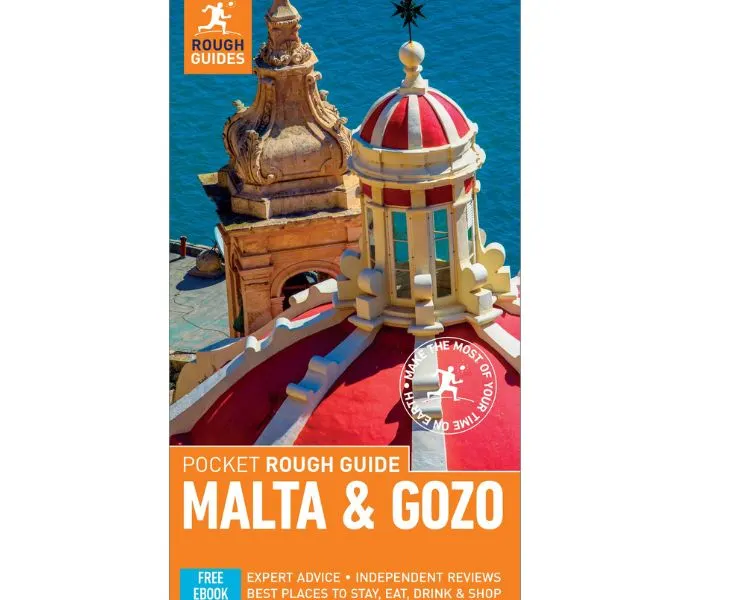
Need a guide book for Malta? We recommend the Pocket Rough Guide to Malta and Gozo
Read Next
Discover delicious food in Malta – where and what to eat
More articles about Malta
Delicious Maltese Food – where and what to eat
Fun things to do in Gozo – the quiet sister island to Malta
Things to do in Malta in a weekend break
Things to do in Valletta, Malta in one day
Enjoy the food and fireworks of a Maltese Festa
A guide to Three Cities Malta – our top things to do
Pin it


Some of the experiences mentioned were provided* on a press trip hosted by Malta Tourism and British Guild of Travel Writers.
* More info on my policies page
This article is originally published at Heatheronhertravels.com



